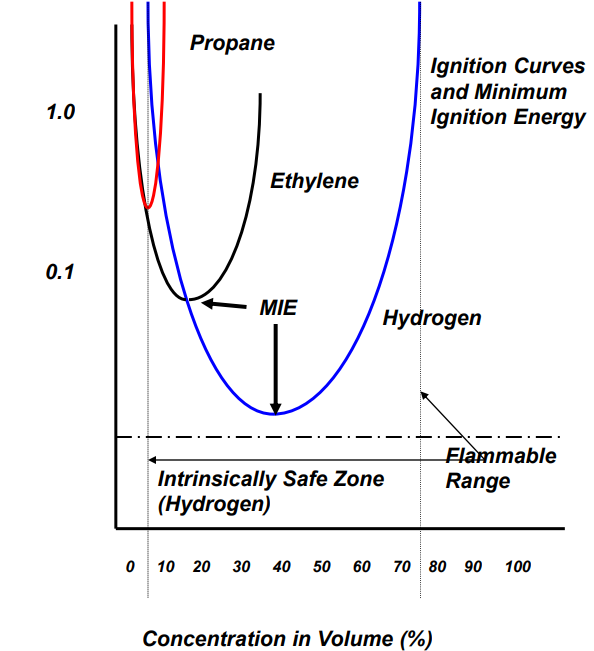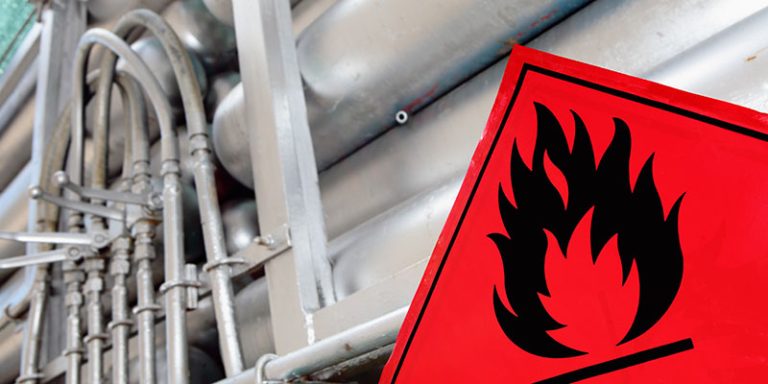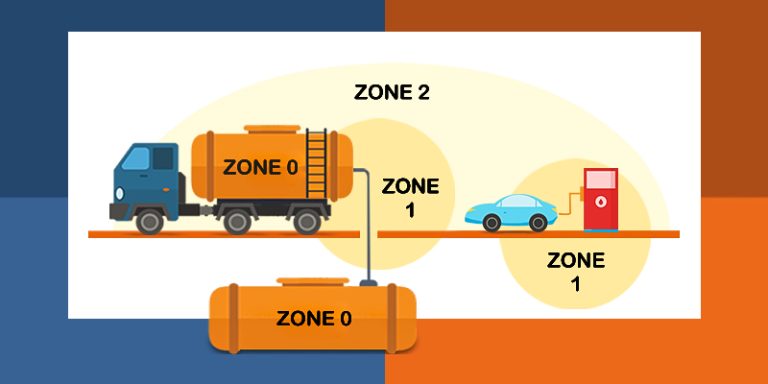Minimum Ignition Energy (MIE) is a significant safety characteristic in the field of explosion protection and prevention. MIE determines the ignition capability of fuel-air mixtures, where the fuel could be combustible vapor, gas, or dust. Having a clear understanding of MIE is essential for industries that handle and process flammable materials, as it helps assess the risk of explosion and implement appropriate safety measures to prevent ignition.
The energy required to ignite a flammable mixture varies widely depending on the specific materials involved. Measuring MIE involves standard procedures for different applications, such as dust clouds, solvent vapors, and gases. Engineers and safety professionals must consider MIE data when designing processes and facilities to minimize the risk of ignition, and thus, avoid catastrophic accidents. Overall, understanding Minimum Ignition Energy is a crucial aspect of ensuring workplace safety and preventing industrial disasters.

Fundamentals of Minimum Ignition Energy
Minimum Ignition Energy (MIE) is a crucial safety characteristic in explosion protection and prevention. It determines the ignition capability of fuel-air mixtures, which can consist of combustible vapor, gas, or dust. MIE is defined as the minimum spark energy required to ignite an ideal concentration of the fuel-air mixture under controlled laboratory conditions.
The ASTM E2019 test is commonly used to measure MIE of a flammable dust. This test employs a capacitive discharge spark to assess the ease and likelihood of ignition of a dispersed dust cloud. It can be run with or without inductance, depending on the material being tested.
Various factors influence a substance’s MIE value, such as particle size, humidity, and temperature. Smaller particles tend to have lower MIE values, making them more susceptible to ignition. Likewise, lower humidity and higher temperatures typically result in more favorable conditions for ignition, reducing the required spark energy.
MIE plays a critical role in assessing the explosibility hazard of organic dust in the workplace. Predicting the MIE of organic dust is essential for the development of appropriate safety measures and guidelines for handling and processing such materials. When dealing with substances that have a low MIE (e.g., <10 mJ), special equipment and operational precautions may be necessary, including the targeted use of inert gas blanketing during unloading processes.
In summary, understanding the fundamentals of Minimum Ignition Energy is crucial for explosion protection and prevention, particularly when handling combustible materials. Accurate assessment and prediction of MIE values enable the development of safe practices and procedures, ultimately contributing to a safer work environment.

Ignition Sources and Critical Factors
Spark Discharge
Spark discharge is a significant ignition source when dealing with combustible gas, vapor, or dust mixtures. It refers to the electrical discharge generated by the flow of electric current through a non-conductive medium, often in the form of an arc between electrodes. This discharge releases energy, which can ignite the fuel mixture if the minimum ignition energy (MIE) is met. Notably, the MIE depends on the particular fuel and oxidizer combination, and it is important to be aware of this value to ensure the safe handling of such materials.
Temperature
Temperature is another critical factor when considering ignition sources, as it influences the ignition process. For a combustible mixture to ignite, its surroundings must reach a particular temperature, known as the ignition temperature. This value varies depending on the fuel and oxidizer combination involved and can be affected by changes in ambient conditions and the laminar flame speed of the mixture. Therefore, understanding the ignition temperature plays a crucial role in managing the risks associated with handling and storing flammable materials.
Pressure
Pressure also plays a vital role in determining the likelihood of ignition. Higher pressure can increase the concentration of a fuel-oxidizer mixture, which in turn influences the flammability and combustion properties of the material. Generally, as pressure increases, the minimum ignition energy required for combustion tends to decrease, making ignition more likely. Conversely, lower pressures typically demand more energy to initiate ignition, making it less likely for the mixture to ignite spontaneously. Maintaining appropriate pressure conditions is essential in controlling the hazards associated with flammable substances.
Types of Combustible Dusts and Gases
Dusts
Combustible dusts are finely divided solid particles that can present a risk of fires and explosions when suspended in the air. These dusts can come from a variety of materials, including organic substances like coal, wood, and grain, as well as metals and synthetic materials. The explosion risk of dust is influenced by factors such as particle size, moisture content, and the concentration of dust particles in the air. Smaller particle sizes are generally associated with a higher risk of ignition and explosion.
Some common combustible dusts include:
- Coal: This organic material is frequently found in power plants and can create explosive dust environments.
- Grain and agricultural dust: Dust generated in grain handling, storage, and processing facilities can lead to devastating explosions.
- Metal dust: Dusts from metals like aluminum, magnesium, and titanium are flammable and can cause explosions in certain conditions.
Gases
Flammable gases are substances that, when mixed with air and exposed to an ignition source, can burn or explode. These gases often have low minimum ignition energy (MIE) values, making them more susceptible to ignition. Gas mixtures are considered explosive when they fall within a specific range of concentrations called explosive limits. To minimize the risk of fires and explosions, proper ventilation, storage, and handling of flammable gases are essential.
Some common flammable gases include:
- Ethane: This is a colorless and odorless gas commonly found in natural gas deposits and used as a fuel.
- Ethanol: A widely used alcohol, ethanol is volatile and highly flammable, making its vapors capable of igniting easily.
- Hydrogen: This colorless and odorless gas has a wide range of flammability, and is used as fuel in various industries.
Understanding the properties and risks of both combustible dusts and flammable gases is crucial for ensuring workplace safety and effective explosion prevention strategies. Proper storage, handling, and ventilation can help mitigate the risks associated with these hazardous materials.
Minimum Ignition Energy in Different Industries
Chemical and Pharmaceutical
In the chemical and pharmaceutical industries, minimum ignition energy (MIE) is a crucial factor to consider in preventing explosions involving fuel-air mixtures, such as combustible vapors, gases, or dust. When designing facilities and processes, engineers must account for the MIE of various substances, such as ethylene, ammonia, and other volatile chemicals. This can help mitigate the risks associated with dust cloud explosions and inadvertent ignition from sparks or other energy sources. For example, ethylene has a relatively low MIE and demands careful attention to ventilation, grounding, and explosion-proof designs.
Food Processing
The food processing industry often involves the handling and processing of fine powders and grain dust, which can pose significant risks for dust explosions if not managed properly. Substances like flour and grain dust can have a low MIE, which necessitates the implementation of proper safety measures. Some of these include:
- Maintaining appropriate dust concentration levels in workspaces
- Installing ventilation systems to minimize dust build-up
- Implementing proper grounding techniques to avoid static electricity buildup
- Using explosion-resistant equipment and designs
Understanding the MIE of these materials is essential in minimizing risks associated with dust explosions in the food processing industry.
Metalworking
Metalworking industries deal with various types of metal powders and dust, some of which can be highly reactive and dangerous if not handled correctly. One prominent example is aluminum, which can form explosive dust-air mixtures if the MIE threshold is exceeded. To minimize the risks associated with metal dusts in the metalworking industry, steps such as these are taken:
- Implementing local exhaust ventilation systems to manage dust concentrations
- Using wet or vacuum-based cutting methods to reduce dust production
- Storing and handling metal powders in designated areas with appropriate safeguards
- Performing regular equipment maintenance and housekeeping to manage dust accumulation
Accounting for the MIE of metal powders and dust in various processes within the metalworking industry is critical in maintaining a safe working environment.
Prevention and Mitigation Strategies
Explosion Prevention
Explosion prevention is a crucial aspect of dealing with materials that exhibit low minimum ignition energy (MIE). Proper prevention techniques and procedures can significantly reduce the risk of explosion due to flammable dusts, deflagration, and detonation events. In addition to addressing hazards associated with MIE, it is important to consider other factors such as the maximum explosion pressure, maximum rate of pressure rise, deflagration index, minimum explosible dust concentration, and minimum ignition temperature (MIT) as part of a comprehensive prevention strategy ^.
Prevention measures include the following:
- Hazard assessment: Regularly evaluate and identify potential sources of ignition, as well as the flammability and explosion properties of materials used in the workplace.
- Hazard communication: Provide training and education to employees regarding the hazards associated with flammable materials, and encourage clear channels for reporting potential risks.
- Maintenance procedures: Implement regular inspection and cleaning routines to minimize dust accumulation and reduce the likelihood of ignition due to static electricity or mechanical friction.
- Engineering controls: Install adequate ventilation systems to reduce potentially explosive concentrations of flammable dusts, as well as eliminate other possible ignition sources (e.g., sparks, embers, hot surfaces).
Combustion Control
In addition to explosion prevention strategies, it is essential to focus on combustion control, which seeks to manage flammability conditions to maintain safer operational conditions for workers and the environment. One key aspect of combustion control is monitoring and controlling the concentration of flammable substances within their lower flammable limits (LFL), ensuring that they remain below explosive levels ^.
Combustion control techniques include:
- Gas monitoring systems: Use continuous gas monitoring systems to detect potential leaks and monitor LFLs in real-time, allowing for rapid response in the event of a hazardous situation.
- Inerting and purging: Implement inerting and purging procedures to reduce the concentration of flammable substances. This can be achieved by introducing an inert gas (such as nitrogen) to displace or dilute the flammable gas or vapor.
- Process control systems: Employ automated process control systems to regulate the conditions within processing equipment, managing variables like temperature, pressure, and mixing rates to prevent the formation of potentially explosive concentrations.
Incorporating these prevention and mitigation strategies contributes significantly towards enhancing health and safety in workplaces where materials with low MIE are present. By following professional guidelines and complying with relevant safety regulations, the risks of explosions and fires can be effectively managed and minimized, promoting a safer working environment for all.
Common Flammable Substances and Their MIE
Minimum Ignition Energy (MIE) is the minimum amount of energy required to ignite a mixture of a flammable substance with air or oxygen. It varies among different substances and is a crucial characteristic for explosion protection and prevention. The following are some common flammable substances and their MIE values.
- Acetaldehyde: This highly flammable compound has an MIE of 0.21 mJ.
- Acetone: Commonly used as a solvent, acetone has an MIE of 1.15 mJ.
- Acrolein: A highly reactive and flammable liquid, acrolein has an MIE of 0.7 mJ.
- Acrylonitrile: With an MIE of 1.12 mJ, acrylonitrile is a flammable organic compound.
One of the most well-known flammable substances is benzene, which has an MIE of 0.20 mJ. The widely used fuel gas, butane, has an MIE of 0.25 mJ. The highly flammable gas 1,3-butadiene has an MIE of 0.13 mJ. Another toxic and flammable gas, carbon monoxide, has an MIE of less than 0.3 mJ.
Common organic materials like cellulose have an MIE of 35 mJ. Cocoa is another flammable substance with an MIE of 30 mJ. Some other highly flammable hydrocarbons include cyclohexane (0.32 mJ), cyclopentane (0.5 mJ), and cyclopropane (0.17 mJ). Dichlorosilane is a flammable gas with an MIE of 0.3 mJ.
Flammable ethers include diethyl ether (0.21 mJ) and diisopropyl ether (0.27 mJ). Ethyl acetate is another volatile solvent with an MIE of 0.7 mJ. The flammable gas ethyl chloride has an MIE of 0.9 mJ. Ethylene oxide, a highly flammable and reactive gas, has a minimum ignition energy of 0.07 mJ.
Other common flammable substances include furan (0.011 mJ), heptane (0.24 mJ), and hexane (0.24 mJ). Isopropyl alcohol is a widely used flammable solvent with an MIE of 1.2 mJ. Different substances have varying minimum explosive concentrations (MECs), which is the lowest concentration of a substance in air that can lead to an explosion when ignited.
Frequently Asked Questions
What factors influence minimum ignition energy?
Several factors influence the minimum ignition energy (MIE) of fuel-air mixtures, including the type of fuel, the fuel concentration, the oxidant concentration (such as oxygen in air), moisture content, and particle size. The physical and chemical properties of the fuel, as well as the surrounding conditions, play a role in determining the MIE.
What is the relationship between minimum ignition energy and minimum ignition temperature?
Minimum ignition energy and minimum ignition temperature are related safety characteristics in explosion protection and prevention. Minimum ignition temperature refers to the lowest temperature at which a given fuel-air mixture will ignite when heated in a controlled environment, while minimum ignition energy is the lowest amount of energy necessary to ignite the mixture. There is often a complex interplay between these two factors since fuels with higher ignition temperatures may also require higher minimum ignition energies.
How is minimum ignition energy measured?
Minimum ignition energy is measured through various experimental methods and tests, such as the Determination of Combustibility UN Test N.1 and Determination of Explosibility (ASTM E1226). These test methods are designed to identify the ignition capability of different fuel-air mixtures and help characterize the explosion potential of various materials.
What is the significance of minimum ignition energy in industrial safety?
Understanding the minimum ignition energy of flammable materials is vital to ensuring industrial safety. By knowing the MIE of specific substances, companies can implement appropriate safety measures to prevent fires and explosions. These measures may include reducing the likelihood of energy sources reaching the minimum ignition energy, minimizing the presence of flammable materials, and using proper ventilation systems to prevent the formation of dangerous fuel concentrations.
Why is knowledge about minimum ignition energy crucial in handling flammable substances?
Knowledge about minimum ignition energy is essential in handling flammable substances, as it enables operators and engineers to develop effective safety procedures for controlling risks associated with fires and explosions. It provides critical insight into the ignition capability of different fuel-air mixtures and helps to inform decisions regarding the storage, transport, and processing of flammable materials in various industrial settings(AIChE).
What standards are used to determine minimum ignition energy?
Various international standards and test methods are used to determine minimum ignition energy, including the Determination of Combustibility UN Test N.1, Determination of Explosibility ASTM E1226, and ASTM E1515. These standards and tests help industries accurately characterize the explosion potential of materials and implement appropriate safety measures to reduce the likelihood of fires and explosions due to insufficient energy management or handling of flammable substances.




